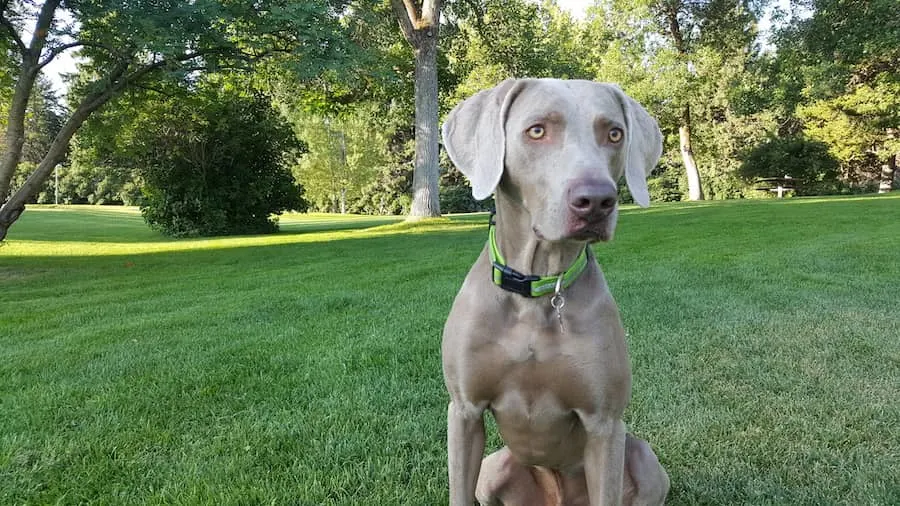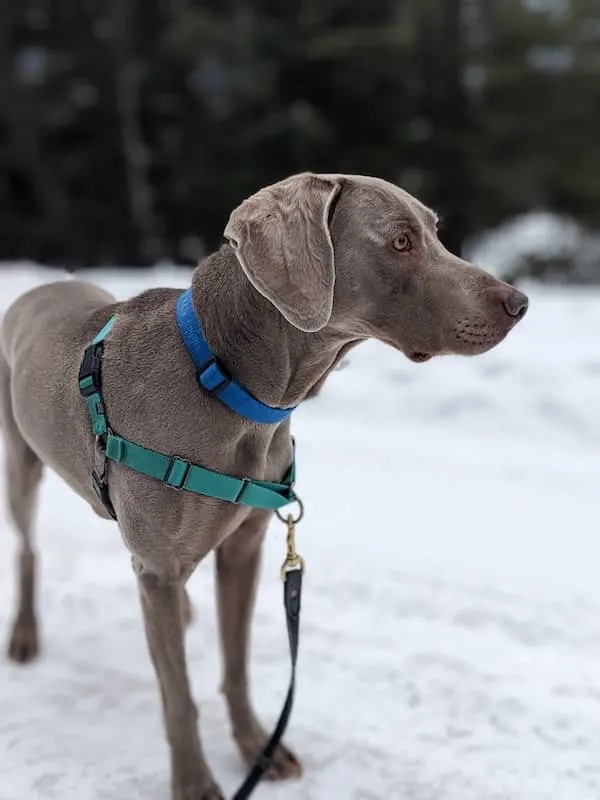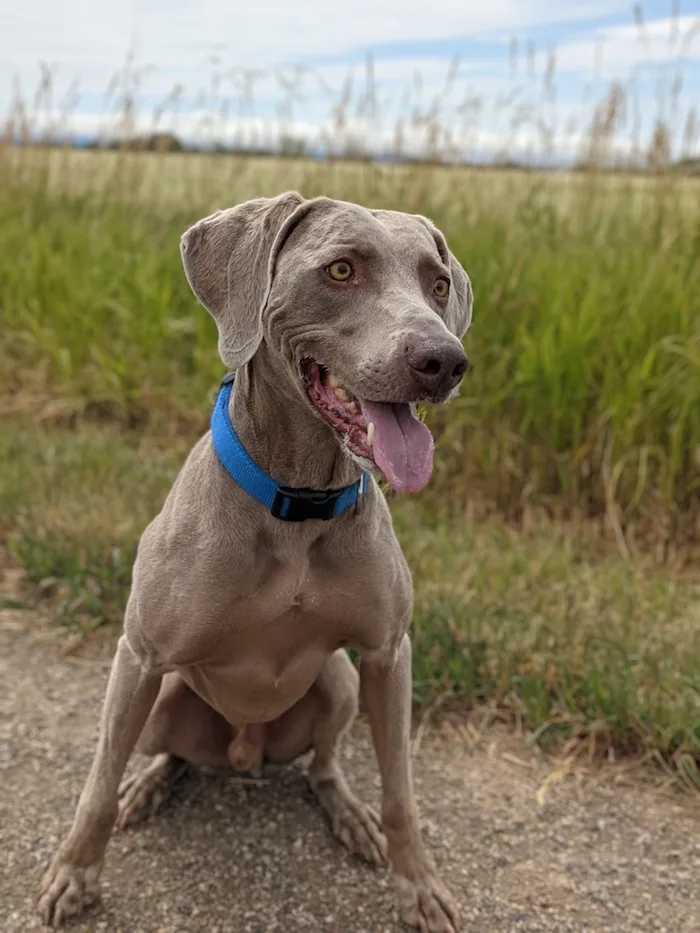It’s normal for dogs to chase squirrels and other small animals! In this article, I’ll share some ideas for how to stop a dog from chasing squirrels in your yard, on walks or on trails.
Why do dogs chase squirrels?
Some dogs have a higher prey drive than others, depending on their breed and personality.
Beagles are bred for tracking and chasing rabbits, for example. Springer spaniels are bred for flushing birds. Many terriers were originally bred for catching rodents.
Other dog breeds are bred for pointing, tracking or chasing prey!
Because of this, it is not possible or fair to try to remove a dog’s instinct for chasing squirrels and other small animals. Instead, you can try to manage your dog’s squirrel chasing the best you can.
Is it bad if my dog chases squirrels?
No, it’s not bad if your dog chases squirrels unless it’s a behavior that you do not like.
For most of us, squirrel chasing is not a big deal, but there are some scenarios where chasing squirrels might be a problem:
- If you don’t have a fenced yard and your dog chases squirrels into the road.
- If your yard is barking at squirrels and driving the neighbors crazy.
- Your dog is obsessed with squirrels during walks and pulls hard on the leash.
- The dog chases squirrels in off-leash areas and can’t be trusted.
How to stop my dog from chasing squirrels in the yard
Take your dog out on a leash for potty breaks
If you need to stop your dog from chasing squirrels in the yard, then you need to remove her opportunity to chase squirrels.
This is simple but takes a lot of work on your end.
You’ll have to take your dog out on a leash for her potty breaks – for now.
This doesn’t have to be forever but will need to be done for a couple of weeks or months while you work on training.
You are blocking your dog from chasing squirrels by keeping her on a leash. This stops the behavior from being reinforced.
When you do see squirrels and your dog is on a leash, you can say “leave it” and reward your dog with food for looking at you.
Use a long leash and high-valued treats to stop dog from chasing squirrels
A regular leash is fine at first, but it’s best to get a 20 or 30-foot long line eventually. This will give your dog more freedom to make decisions. That way you can reward him for choosing not to chase squirrels or correct him if he does.
Let your dog wander around the yard when you know there might be squirrels around.
Once you spot a squirrel, step on the leash and get your dog’s attention with the treats. Say “watch me” or “here” or whatever cue you want to use.
Reward your dog for looking at you instead of the squirrel.
It’s easier if you’re able to stand between your dog and the squirrel and move towards your dog, even bumping into him to get him to back up or sit.
Hold the treat right up to your dog’s nose, if needed. Keep popping small treats into his mouth as he pays attention to you and ignores the squirrel. “Good boy.”
Practice every day for a couple of weeks
Your dog’s behavior is not going to change overnight. The more you reward your dog for looking at you instead of the squirrels, the more this behavior will get reinforced.
Try to practice for a few short sessions each day, if possible.
You will need to use very high-valued food at first. It could be hot dogs, chicken, ground beef, steak or salmon.
As your dog is successful, you may be able to use regular treats but keep mixing it up with some high-valued treats every so often!
You’ll need to be out in the yard supervising your dog for her exercise or find other ways for her to get exercise such as long walks.
Work on your dog’s general obedience
Yes, this is boring but it’s important!
If your dog does not come when called or stay when told when there are no distractions, how can you expect him to do so around big distractions such as squirrels?
Work on basic obedience like come, stay, sit, down and heel out in the yard when there are squirrels around. Keep your dog on a leash and use high-valued treats so he can be successful.
An obedient dog has more self control!
Increase your dog’s exercise
Most of our dogs need more exercise. If your dog is having an issue with chasing squirrels, it will only help him out if you’re able to provide him with enough exercise.
That probably means longer and more frequent walks than he’s already getting.
Provide your dog with appropriate ways to chase and sniff
Provide your dog with another way to use his prey instincts. This could be playing fetch, using a “flirt pole” toy or signing up for a nosework class or “barn hunt” class.
Sometimes games of fetch or using a flirt pole get the dog even more “riled” up instead of tiring him out or relaxing him. If that’s the case, keep the game to a short session of 5 or 10 minutes and do some calming work with your dog like working on down and stay before and after the game.
Nosework is often relaxing to dogs. In nosework, your dog learns to find various scents or odors in different environments.
And in the sport of “barn hunt” they get to look for actual rats in a controlled setting.
Finally, one of the simplest ways to give your dog a good opportunity to sniff is to put him on a long leash and scatter some food or treats in a field for him to find. This could be an empty soccer field or even in your own backyard.
How to stop my dog from chasing squirrels during walks
You might not mind if your dog chases squirrels in the yard, but what about when he obsesses about squirrels during walks?
Here are some ideas that can help.
My dog pulls when he sees squirrels! What to do?
Walk him where there are no animals
As a temporary solution, walk your dog where there are no squirrels or at a time of day when the squirrels are less active. I realize this is easier said than done.
As you work on training your dog, walk him in areas with more and more potential distractions.
Use the right “no-pull” device to stop dog from chasing squirrels
A lot of people walk their dogs on a regular buckle collar or on a regular harness with a clip on the back. This makes it very easy for the dog to pull you around, even if you have a small dog!
Instead, using a no-pull device may be all you need to get a little more control of your dog on walks.
The options for “no pull” tools are endless. You have to choose what works best for you and your dog.
Tools such as prong collars and slip collars have a bad rap as being “punishing” or “aversive” tools. And that can be true. However, the dog gets to decide what is aversive to him. We do not get to decide for him.
For example, my dogs love their prong collars. It means they’re going for a walk! They do not love their no-pull harnesses or their Gentle Leaders.
The harnesses and the Gentle Leaders feel more restricting to my dogs and that is why they will actually walk the other way when I get out these tools.
We have articles on all of these tools here on That Mutt if you need more information.
Some options for “no pull” devises to try:
- Martingale collar
- Slip collar
- Prong collar
- No-pull harness such as EasyWalk harness
- Gentle Leader or Halti
Use a 6-foot leather leash
I recommend a leather leash vs. a nylon leash or retractable leash. Leather leashes are easier to grip and will also give you more control.
Nylon tends to slide through your hands and retractable lashes are a bad idea if you have a dog who loves to bolt after prey.
Carry a treat bag and treats to stop squirrel chasing
Carry high-valued treats on your walk in a treat pouch. High-valued treats could be pieces of cheese, ham, chicken, etc.
When you see a squirrel, get your dog’s attention on the food and reward him for looking at you.
Pop several small treats in his mouth as he looks at you instead of the squirrel and keep moving forward.
When we stop moving, it makes it easier for the dog to stop and fixate on the squirrel. It’s usually easier for the dog to ignore the squirrel if we keep moving.
Turn and walk the other direction
Sometimes it’s helpful to turn and walk the other direction when your dog is fixated on a squirrel, bird or rabbit. It’s easier to do a “u-turn” where you turn into your dog (vs away from your dog), gently bumping him back as you turn and get him to walk with you.
Hold a treat right at your dog’s nose as you do this.
Stopping a dog from chasing squirrels takes time
Your dog will need several training sessions over several weeks or months to overcome the issue of squirrel chasing, so stick with it. Be consistent and follow your plan.
If you are not seeing progress, consider hiring a dog trainer who can work with you and your dog one on one for a training session or two.
How to stop my dog from chasing squirrels while hiking
Depending on your specific dog and the environment, you may need to keep your dog on a leash indefinitely when you visit certain parks or trails.
However, there may be certain off-leash areas where you want to work on training your dog. If that’s the case, I recommend you start with a long leash and carry high-valued treats in a treat pouch. Long leashes work better when there are not a lot of other dogs running around.
Give your dog treats just for checking in with you, even when there are no squirrels around.
When you do see a squirrel and your dog chooses to look at you instead of chase the squirrel, give him a “jackpot” of treats and lots of praise.
If it seems like he’s going to go after the squirrel, then step on the long leash and try to get his attention back on you. Praise him for doing so.
You may need to run in the opposite direction in order to be more interesting than the squirrel! Praise him for following you.
Put a bear bell on your dog
Since we live in bear country, sometimes I clip a bear bell to my dog’s collar when we are hiking. This is supposed to make enough noise to warn a bear that we’re coming up the trail – to avoid startling the bear.
A bell can also work to scare off other wildlife like deer, rabbits and squirrels before you and your dog get close enough to trigger your dog’s prey drive. This is just an option to consider.
I also like that the bell on my dog warns other dogs, hikers or bikers that we are approaching, especially when my dog is off leash.
Work on coming when called in general
Make a point to practice coming when called more often in all sorts of scenarios but where you know your dog will listen and be successful.
Give a big reward, whatever food or toy he loves, or release him to go back to playing (when possible). It’s good to continue building a solid reinforcement history of him coming when called.
Using an e-collar to stop a dog from chasing squirrels
You do not have to use an e-collar to stop your dog from chasing squirrels, but it is an option if you choose to go that route.
The e-collar is tricky because a dog is in such a riled-up state of mind, he will need a harder correction to even notice it. Under no distractions, he would likely respond to a mild correction/vibrate.
So that will take a little figuring out to get the correction level right for him.
If you choose to use an e-collar, you want a high-quality brand such as Garmin or SportDog. Test the correction level on your wrist first so you know what level your dog will receive. You want to be comfortable with your decision and know you are not hurting your dog.
Give a correction immediately when your dog goes after the squirrel and then praise/food when he focuses on you.
You can pair “leave it!” with the correction, especially if your dog already knows “leave it.”
Once he breaks focus from the squirrel for even a moment, really praise and reward him.
Note that some dogs, like certain hounds, will have such a high prey drive that they may appear to ignore any level of correction. In that case, the e-collar route may not work.
Remember that chasing small animals is natural to a lot of dogs and we can only do the best we can to try to manage squirrel chasing.
What else would you add to this list?
In the comments, please share what has or hasn’t worked for your dog. It will be helpful for others struggling with how to stop a dog from chasing squirrels.




Janie
Thursday 11th of January 2024
It’s hard bc squirrels are everywhere and sometimes they just pop up in front of you. I think it’s cute how many dogs react but they can get so stimulated and really pull. It’s really hard to catch a squirrel not sure they get that!!